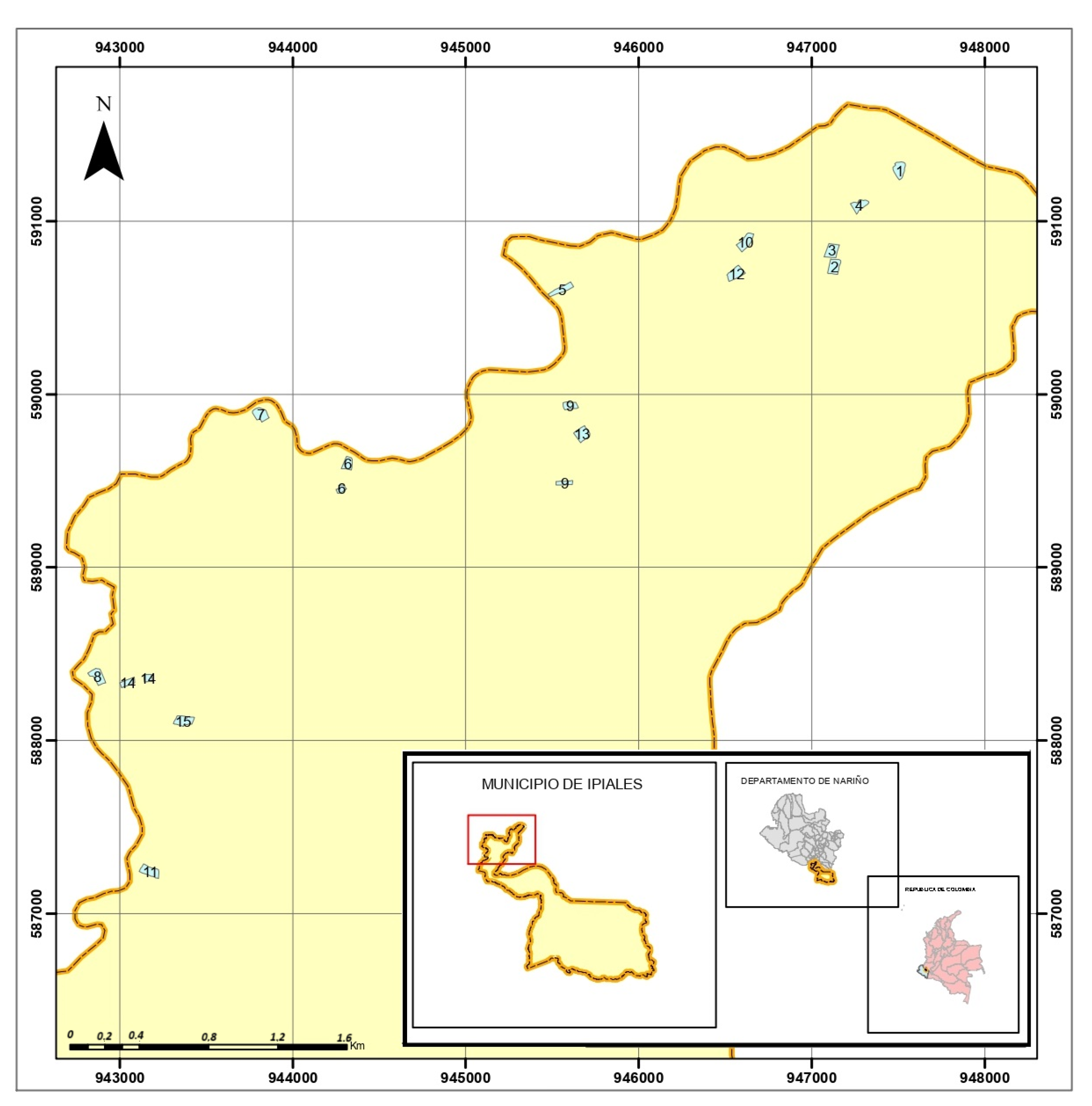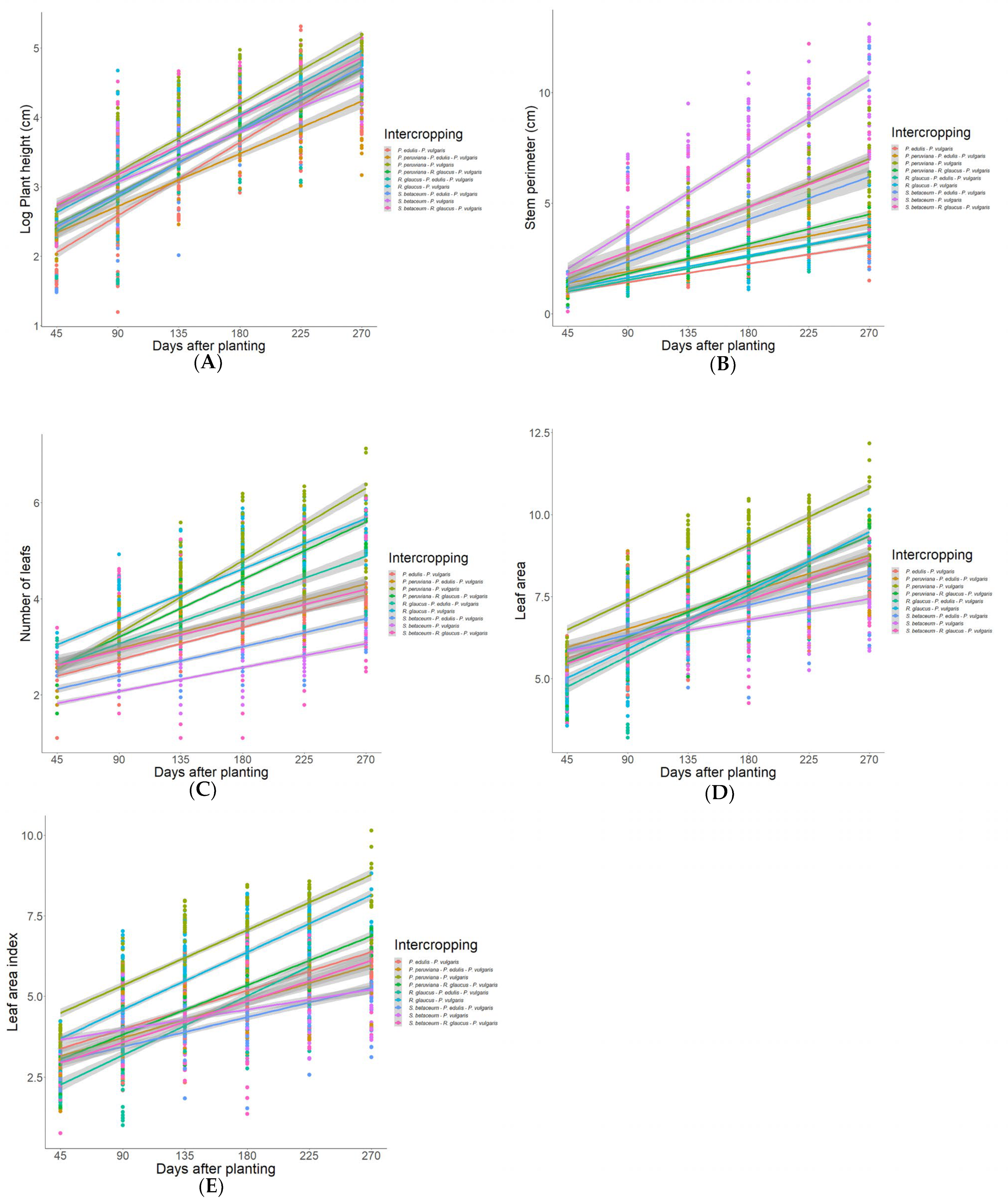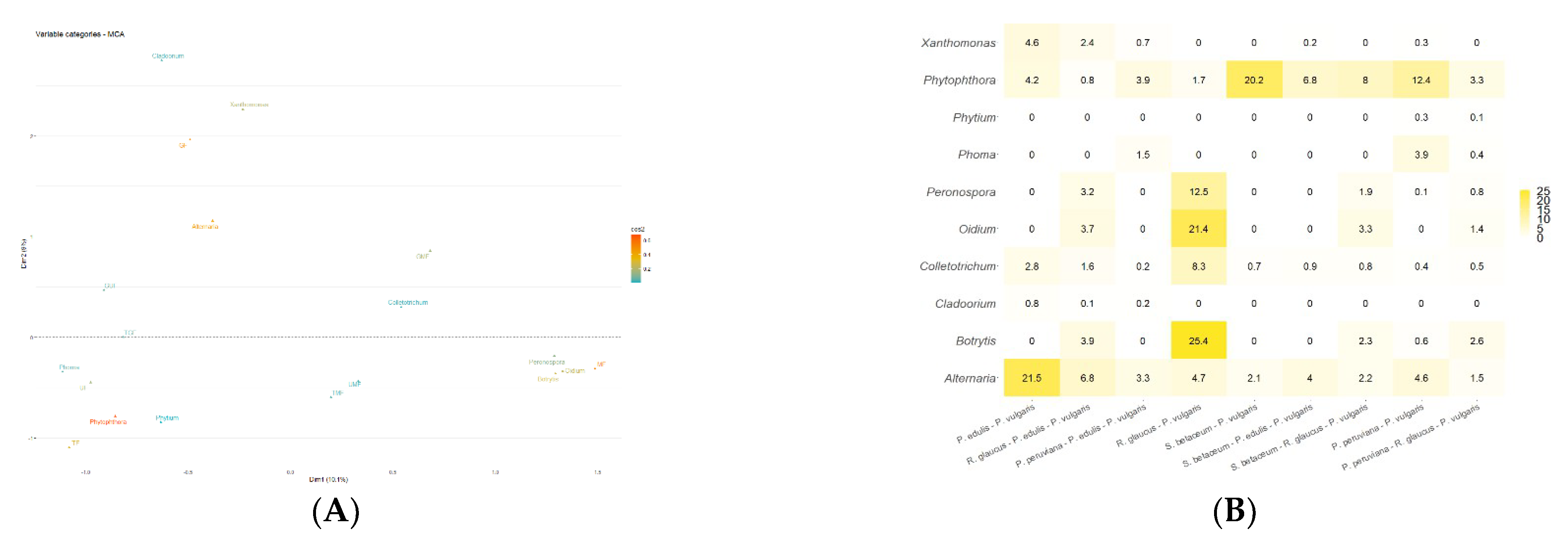Effect of Fertilization in Companion Cropping Systems of Andean Fruit Trees in the Municipality of Ipiales
Abstract
1. Introduction
2. Materials and Methods
2.1. Location
2.2. Planting Material
2.3. Experimental Design
2.4. Variables Evaluated
2.5. Information Analysis
2.6. Training with Producers and Dissemination of the Information Generated in This Project
3. Results
3.1. Functional Analysis of Growth and ANDEVA Analysis of Variance of the Regression Coefficients Obtained
3.2. Determination of the Incidence of Pests and Diseases
3.3. Field Schools
4. Discussion
4.1. Functional Analysis of Growth and ANDEVA Analysis of Variance of the Regression Coefficients Obtained
4.2. Determination of the Incidence of Pests and Diseases
4.3. Field Schools
5. Conclusions
Author Contributions
Funding
Data Availability Statement
Acknowledgments
Conflicts of Interest
References
- Moreno, M.A.M. Efectos de la Labranza Convencional y Labranza de Conservación en la Producción Agrícola: Revisión de Literatura; Escuela Agrícola Panamericana, Zamorano: Tegucigalpa, Honduras, 2021; 43p, Available online: https://bdigital.zamorano.edu/server/api/core/bitstreams/a8681a48-2637-44e2-9867-5b12a8ee8a51/content (accessed on 12 May 2024).
- Benavides, M.A. Alternativas Para la Comercialización Internacional de Fertilizantes Agrícolas de la Empresa Agrochuldey el Fomento a Las Exportaciones; UPEC: Paris, France, 2022. [Google Scholar]
- Higuera, J.M.I.; Villa, C.U. Estudio de Factibilidad Para el Proyecto de Fabricación de Módulos de Acuaponía y Prestación de Servicios Afines Para el Área Rural de Uribia. Manaure y Maicao en La Guajira de la Fundación Aquaponics Relief. 2020. Available online: https://bibliotecadigital.udea.edu.co/handle/10495/16651 (accessed on 12 May 2024).
- FAO. El Mercado Mundial de Fertilizantes: Balance de la Situación de un Mercado en Dificultades; Organanización de La Naciones Unidad Para La Alimentación y La Agricultura: Rome, Italy, 2022; Available online: https://investing.com (accessed on 12 May 2024).
- Rivas, A.C.; Melendez, J.P.; Mayorquín, N. Alternativas microbiológicas para la remediación de suelos y aguas contaminados con fertilizantes nitrogenados Microbiological alternatives for the remediation of soils and water contaminated with nitrogen fertilizers. Sci. Tech. Año XXV 2020, 25, 172–183. [Google Scholar]
- Ministerio de Agricultura. Plan Departamental de Extension Agropecuaria del Departamento de Nariño PDEA—Nariño; Gobernacion de Nariño: Nariño, Colombia, 2019; 222p. Available online: https://www.minagricultura.gov.co/ministerio/direcciones/Documents/PDEA%27sAprobados/PDEA Nariño.pdf%0A (accessed on 12 May 2024).
- Alcaldía Municipal de Ipiales. Plan de Desarrollo 2020–2023 Hablemos con hechos. Turismo Activo y Progresivo; Fundación Empresarios por la Educación: Bogota, Columbia, 2024; p. 141. Available online: https://www.obsgestioneducativa.com/download/plan-de-desarrollo-municipal-ipiales-2020-2023/ (accessed on 12 May 2024).
- Instituto Colombiano Agropecuario—ICA. En Ipiales, Productores de Uchuva se Blindan Contra las Moscas de la Fruta; Ministerio de Agricultura y Desarrollo Rural: Bogotá, Columbia, 2019. Available online: https://www.ica.gov.co/noticias/ica-productores-uchuva-blindan-moscas-fruta-narino (accessed on 12 May 2024).
- Martínez-Camacho, Y.D.; Negrete-Yankelevich, S.; Maldonado-Mendoza, I.E.; la Mora, A.N.-D.; Amescua-Villela, G. Agroecological Management with Intra- and Interspecific Diversification as an Alternative to Conventional Soil Nutrient Management in Family Maize Farming. Agroecol. Sustain. Food Syst. 2022, 46, 364–391. [Google Scholar] [CrossRef]
- Morales-Belpaire, I.; Alfaro-Flores, A.; Ramos, K.L.; Velarde, O.P.; Ordonez, P.A.; Armengot, L. Soil Quality Indicators under Five Different Cacao Production Systems and Fallow in Alto Beni, Bolivia. Agrofor. Syst. 2024, 2024, 1–16. [Google Scholar] [CrossRef]
- Tinoco-Jaramillo, L.; Vargas-Tierras, Y.; Habibi, N. Agroforestry Systems of Cocoa (Theobroma cacao L.) in the Ecuadorian Amazon. Forests 2024, 15, 195. [Google Scholar] [CrossRef]
- Prabhu, R.; Barrios, E.; Bayala, J.; Diby, L.; Donovan, J.; Gyau, A.; Graudal, L.; Jamnadass, R.; Kahia, J.; Kehlenbeck, K.; et al. Agroforestry: Realising the Promise of an Agroecological Approach. In Agroecology for Food Security and Nutrition: Proceedings of the FAO International Symposium, Rome, Italy, 18–19 September 2014; Food and Agriculture Organization of the United Nations: Rome, Italy, 2015; pp. 201–224. [Google Scholar]
- Aguirre Cuellar, B.; Lobo, J.C. Shading in Family Coffee Farms as an Environmental Incentive Promoter for Ecosystem Services in Tolima, Colombia. Int. J. Agric. Sustain. 2022, 20, 1015–1027. [Google Scholar] [CrossRef]
- Alvez, N.V.; Alayon Luaces, P. Evaluación de policultivos frutihortícolas agroecológicos del Nordeste Argentino. Bol. Soc. Argent. Bot. 2020, 55, 273–284. [Google Scholar] [CrossRef]
- Gómez Herrera, D.A.; Muñoz Monsalve, C. Análisis del Comportamiento Morfológico de las Variables Altura y Diámetro de Tallo, en los Sistemas de Siembra Mono Cultivo y Asocio, de las Especies Aguacate (Persea americana) Variedad Hass y Tomate de Árbol (Solanum betaceum), Durante 12 Meses, en el. 2020. Available online: https://repository.unad.edu.co/bitstream/handle/10596/39011/dagomezhe.pdf?sequence=1&isAllowed=y (accessed on 12 May 2024).
- Rosero Alpala, M.G.; Tapie, W.A.; Rosero Alpala, D.A. Diversidad fenotípica de papas nativas en las comunidades indígenas de la etnia de los Pastos (Nariño, Colombia): Agricultura ecológica para la seguridad alimentaria y el desarrollo rural. Rev. Peru. Biol. 2020, 27, 509–516. [Google Scholar] [CrossRef]
- Tumbani, Z. Evaluacion de la Asociacion con dos Especies Fabaceas (Crotalaria júncea y Lupinus mutabilis) con el Cultivo de Cilantro (Coriandrum sativum L.) en Invernadero de la Comunicad de la Comunidad Sullkataca baja del Municipio de Laja; Universidad Mayor de San Andrés: San Andrés, Bolivia, 2018; pp. 50–107. Available online: http://dspace.ups.edu.ec/handle/123456789/17965 (accessed on 12 May 2024).
- Velasquez-Vasconez, P.A.; Andrade Díaz, D. LeafArea Package: A Tool for Estimating Leaf Area in Andean Fruit Species. Int. J. Plant Biol. 2024, 15, 102–109. [Google Scholar] [CrossRef]
- Gardner, E.S. Exponential smoothing: The state of the art. J. Forecast. 1985, 4, 1–28. [Google Scholar] [CrossRef]
- Popat, R.; Banakara, K. Doebioresearch: Analysis of Design of Experiments for Biological Research. 2020. Available online: https://CRAN.R-project.org/package=doebioresearch (accessed on 28 May 2022).
- Wickham, H. ggplot2: Elegant Graphics for Data Analysis; Springer: New York, NY, USA, 2016. [Google Scholar]
- Sébastien, L.; Julie, J.; François, H. FactoMineR: An R Package for Multivariate Analysis. J. Stat. Softw. Found. Open Access Stat. 2008, 25, 1–18. [Google Scholar]
- López Cerda, I.G. Análisis de Cuatro Cultivos Precolombinos en Asocio, Establecidos en dos Métodos de Labranza: Camellones Prehispánicos y Labranza Convencional. Diriamba, Carazo 2018; Universidad Nacional Agraria: Managua, Nicaragua, 2018; Available online: https://repositorio.una.edu.ni/4307/ (accessed on 12 May 2024).
- Paola De Sá, F.; Cerioni Belniaki, A.; Panobianco, M.; Gabira, M.M.; Kratz, D.; Lima, E.A.D.; Wendling, I.; Luiz Esteves Magalhães, W. Peach palm residue compost as substrate for Bactris gasipaes self-sustaining seedlings production. Int. J. Recycl. Org. Waste Agric. 2024, 9, 183–192. [Google Scholar] [CrossRef]
- Rebolledo-Martínez, L.; Megchún-García, J.V.; Rebolledo-Martínez, A.; Orozco-Corona, D.M. Association of Persian Lime (Citrus latifolia) and Coconut Palm (Cocos nucifera L.) Trees with the Contribution of Dry Matter by Annual Crops. Ibero-Am. J. Bioecon. Clim. Change 2019, 5, 1248–1266. [Google Scholar] [CrossRef]
- Larramendi, L.A.R.; Hernández, F.G.; Castro, H.G.; Flores, M.F.; Castañeda, J.C.G.; Ruiz, R.P. Leaf Anatomy Related to the Photosynthetic Pathway in Coffee Trees (Coffea arabica L.; var. Caturra rojo) Exposed to Different Levels of Solar Radiation in the Sierra Maestra, Granma, Cuba. Acta Agron. 2019, 65, 248–254. [Google Scholar] [CrossRef]
- Fischer, G.; Melgarejo, L.M. The ecophysiology of cape gooseberry (Physalis peruviana L.)—An Andean fruit crop. A review. Rev. Colomb. Cienc. Hortíc. 2020, 14, 76–89. [Google Scholar] [CrossRef]
- Liu, Y.; Ge, T.; Wang, J. Long-term effects of organic and inorganic fertilizers on soil organic matter and microbial community structure in a tropical agricultural ecosystem. J. Clean. Prod. 2020, 246, 118993. [Google Scholar]
- Goss, M.J.; Tubeileh, A.; Goorahoo, D. A Review of the Use of Organic Amendments and the Risk to Human Health. Agric. Ecosyst. Environ. 2019, 272, 224–239. [Google Scholar]
- Singh, B.P.; Setia, R.; Marschner, P. Organic amendments enhance soil functioning and crop performance in various agroecosystems: A review. Soil Use Manag. 2018, 34, 592–602. [Google Scholar]
- Chivenge, P.; Vanlauwe, B.; Six, J. Does the combined application of organic and mineral nutrient sources influence maize productivity? A meta-analysis. Agron. Sustain. Dev. 2011, 31, 143–156. [Google Scholar] [CrossRef]
- Möller, K. Assessment of alternative farm practices in organic farming using life cycle assessment methodology: A review. Agron. Sustain. Dev. 2018, 38, 23. [Google Scholar]
- Czarnecka, D.; Czubacka, A.; Agacka-Mołdoch, M. The occurrence of fungal diseases in maize in organic farming versus an integrated management system. Agronomy 2022, 12, 558. [Google Scholar] [CrossRef]
- Amata, R.L.; Otipa, M.J.; Waiganjo, M.; Wasilwa, L.A. Management strategies for fungal diseases in passion fruit production systems in Kenya. Acta Hortic. 2009, 911, 207–213. [Google Scholar] [CrossRef]
- Fones, H.N.; Fisher, M.C.; Gurr, S.J. Emerging Fungal Threats to Plants and Animals Challenge Agriculture and Ecosystem Resilience. In The Fungal Kingdom; Wiley: Hoboken, NJ, USA, 2017. [Google Scholar] [CrossRef]
- Jabbour, R.; Barbercheck, M.E. Soil management effects on entomopathogenic fungi during the transition to organic agriculture in a feed grain. Biol. Control. 2009, 51, 435–443. [Google Scholar] [CrossRef]
- Fisher, M.C.; Gurr, S.J.; Cuomo, C.A.; Blehert, D.S.; Jin, H. Threats posed by the fungal kingdom to humans, wildlife, and agriculture. MBio 2020, 11, 10–1128. [Google Scholar] [CrossRef]
- Altieri, M.A.; Nicholls, C.I. Agroecology: Principles for designing sustainable farming systems. Agron. J. 2020, 112, 5031–5043. [Google Scholar] [CrossRef]
- Gurr, G.M.; Wratten, S.D.; Luna, J.M.; Snyder, W.E. Integrated pest management for sustainable agriculture. Agric. Ecosyst. Environ. 2019, 274, 67–73. [Google Scholar]
- Wezel, A.; Bellon, S.; Doré, T.; Francis, C.; Vallod, D.; David, C. Agroecology as a science, a movement, and a practice: A review. Agron. Sustain. Dev. 2021, 41, 38. [Google Scholar] [CrossRef]
- Friis-Hansen, E.; Duveskog, D.; Taylor, E.W. Farmer field schools: A transformative learning approach in rural Africa. J. Agric. Educ. Ext. 2020, 26, 29–44. [Google Scholar]
- Davis, K.; Lion, K.A.; Ramasamy, S. Agricultural extension and rural advisory services: Understanding the capacities needed to adapt to climate change. Glob. Food Secur. 2021, 28, 100498. [Google Scholar]
- Mbow, C.; Van Noordwijk, M.; Luedeling, E.; Neufeldt, H.; Minang, P.A.; Kowero, G. Agroforestry solutions to address food security and climate change challenges in Africa. Curr. Opin. Environ. Sustain. 2019, 6, 61–67. [Google Scholar] [CrossRef]
- Murphy, J.; Lyon, S.; Dalzell, B. Building community resilience through farmer field schools: A review of evidence from African case studies. J. Rural. Stud. 2019, 72, 110–121. [Google Scholar]
- Franzel, S.; Sinja, J.; Simpson, B. Farmer-to-farmer extension in Kenya: The perspectives of volunteer farmer trainers on their motivations, challenges, and experiences. Dev. Pract. 2014, 24, 403–414. [Google Scholar]
- Lee, J.; Settle, Q. Integrating biosecurity into agricultural extension programs: Lessons from COVID-19. J. Agric. Educ. 2021, 62, 95–109. [Google Scholar]
- Tomich, T.P.; Brodt, S.; Dahlgren, R.; Scow, K.; Stephens, S. Agroecology for food security and resilience in the face of climate change. Glob. Food Secur. 2019, 4, 11–18. [Google Scholar]





| Name—Plot | Block/System | X | Y | Area (m2) | Masl |
|---|---|---|---|---|---|
| Tablon | 1-low/1 | 947,277.0898 | 591,090.2 | 5072 | 2655 |
| Cundala | 1-low/2 | 947,119.3487 | 590,739.8 | 6839 | 2586 |
| Chapicha | 1-low/3 | 945,570.4425 | 590,613.2 | 5003 | 2676 |
| Rancheria | 1-low/4 | 947,074.3692 | 590,816.7 | 6418 | 2620 |
| Santa Barbara | 1-low/5 | 947,507.7808 | 591,300.7 | 5237 | 2576 |
| Culacal | 2-medium/1 | 944,307.8386 | 589,604.8 | 6358 | 2686 |
| Cundala | 2-medium/2 | 945,619.9373 | 589,926.4 | 5470 | 2742 |
| Tuquer | 2-medium/3 | 943,785.2733 | 589,759.5 | 5190 | 2695 |
| Churumbuta | 2-medium/4 | 946,619.0676 | 590,880.7 | 5087 | 2751 |
| Yerba buena | 2-medium/5 | 942,863.7872 | 588,375.7 | 6593 | 2736 |
| Capuli | 3-high/1 | 943,370.221 | 588,113.5 | 5178 | 2812 |
| Churumbuta Laguna de vaca | 3-high/2 | 946,547.2773 | 590,646.6 | 5120 | 2768 |
| campanario | 3-high/3 | 943,103.9658 | 588,347.8 | 5107 | 2800 |
| Cundala | 3-high/4 | 945,680.5052 | 589,754.3 | 8276 | 2770 |
| Chuchala | 3-high/5 | 943,173.5561 | 587,244.1 | 5140 | 2753 |
| FV | G.L | TH | SP | NL | LA | LAI |
|---|---|---|---|---|---|---|
| Block | 2 | 0.029 ns | 0.023 ns | 4989.3 * | 0.135 ns | 0.136 ns |
| Companion | 8 | 0.034 * | 1.621 ** | 16,039.7 ** | 0.517 * | 0.525 * |
| Fertilization | 2 | 0.001 ns | 0.027 ns | 41.4 ns | 0.003 ns | 0.417 ns |
| Companion × Fertilization | 16 | 0.001 ns | 0.018 ns | 252.9 ns | 0.006 ns | 0.650 ns |
| Error a | 15 | 0.029 | 0.07381 | 1203.9 | 176 | 0.173 |
| Error b | 34 | 0.003 | 0.01091 | 243.4 | 0.009 | 0.009 |
| Mean | 0.478 | 0.886 | 62.48 | 0.7 | 0.17 | |
| R2 | 0.874 | 0.97 | 0.952 | 0.955 | 0.955 | |
| CV (%) | 12.09 | 11.78 | 24.97 | 14.02 | 14.03 | |
| Treatment | TH | SP | NL | LA | LAI |
|---|---|---|---|---|---|
| UF | 24.23 a | 1.08 b | 117.66 ab | 0.93 ab | 0.92 ab |
| MF | 19.01 ab | 0.50 c | 134.47 a | 0.96 ab | 0.91 ab |
| MGF | 18.19 ab | 0.56 c | 59.63 cd | 1.02 a | 1.36 a |
| TMF | 15.93 ab | 1.06 b | 58.56 cd | 0.69 ab | 0.68 abc |
| GF | 14.95 ab | 0.45 c | 34.89 de | 0.64 adc | 0.62 abc |
| UGF | 14.74 ab | 0.57 c | 28.65 de | 0.44 c | 0.47 c |
| UMF | 14.55 ab | 0.71 c | 84.31 bc | 0.75 abc | 0.72 abc |
| TGF | 13.03 b | 1.08 b | 19.58 e | 0.51 bc | 0.49 c |
| TF | 11.38 b | 1.80 a | 13.26 e | 0.33 c | 0.38 c |
| UF | 24.23 a | 1.08 b | 117.66 ab | 0.93 ab | 0.92 ab |
Disclaimer/Publisher’s Note: The statements, opinions and data contained in all publications are solely those of the individual author(s) and contributor(s) and not of MDPI and/or the editor(s). MDPI and/or the editor(s) disclaim responsibility for any injury to people or property resulting from any ideas, methods, instructions or products referred to in the content. |
© 2024 by the authors. Licensee MDPI, Basel, Switzerland. This article is an open access article distributed under the terms and conditions of the Creative Commons Attribution (CC BY) license (https://creativecommons.org/licenses/by/4.0/).
Share and Cite
Moran-Chamorro, O.J.; Andrade-Díaz, D.; Chirivi-Salomon, J.S.; Velasquez-Vasconez, P.A. Effect of Fertilization in Companion Cropping Systems of Andean Fruit Trees in the Municipality of Ipiales. Horticulturae 2024, 10, 1107. https://doi.org/10.3390/horticulturae10101107
Moran-Chamorro OJ, Andrade-Díaz D, Chirivi-Salomon JS, Velasquez-Vasconez PA. Effect of Fertilization in Companion Cropping Systems of Andean Fruit Trees in the Municipality of Ipiales. Horticulturae. 2024; 10(10):1107. https://doi.org/10.3390/horticulturae10101107
Chicago/Turabian StyleMoran-Chamorro, Ovidio Javier, Danita Andrade-Díaz, Juan Sebastian Chirivi-Salomon, and Pedro Alexander Velasquez-Vasconez. 2024. "Effect of Fertilization in Companion Cropping Systems of Andean Fruit Trees in the Municipality of Ipiales" Horticulturae 10, no. 10: 1107. https://doi.org/10.3390/horticulturae10101107
APA StyleMoran-Chamorro, O. J., Andrade-Díaz, D., Chirivi-Salomon, J. S., & Velasquez-Vasconez, P. A. (2024). Effect of Fertilization in Companion Cropping Systems of Andean Fruit Trees in the Municipality of Ipiales. Horticulturae, 10(10), 1107. https://doi.org/10.3390/horticulturae10101107










